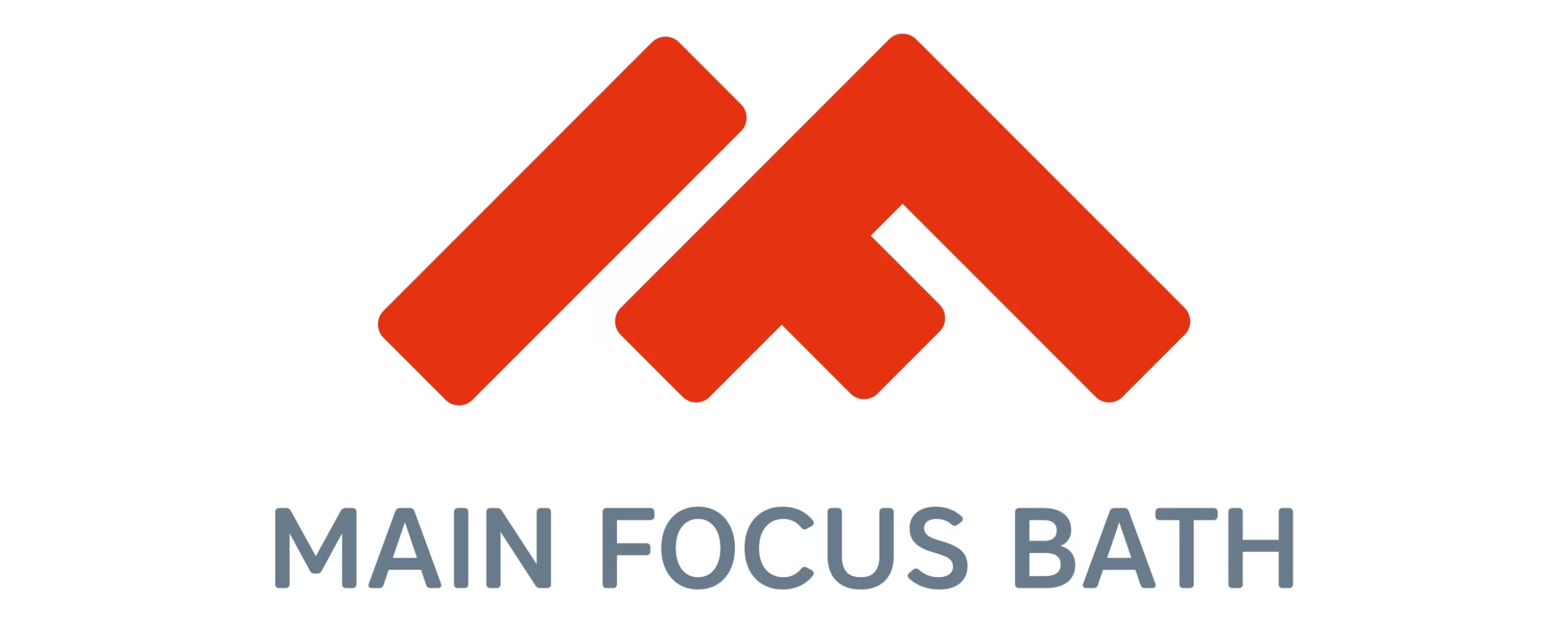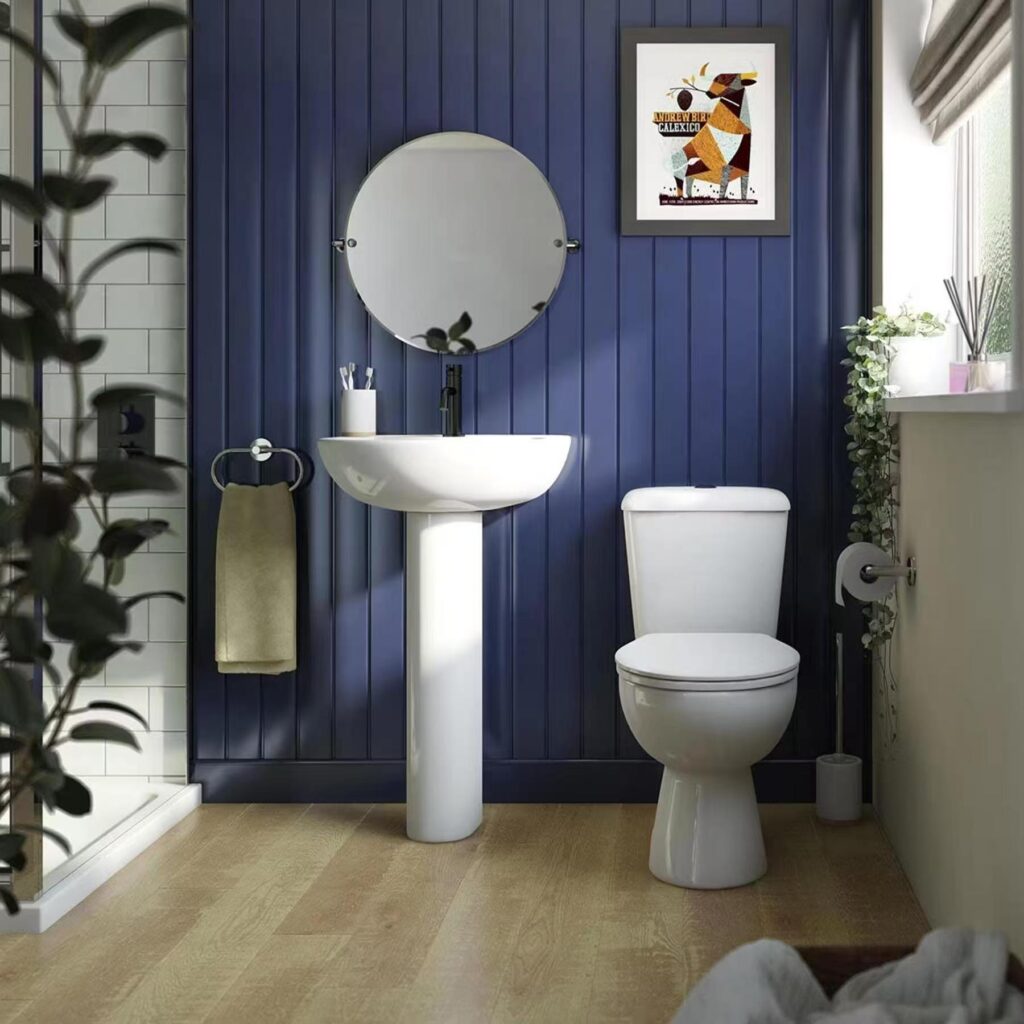Pagpapakilala
Space constraints in modern bathrooms have become a growing challenge for interior designers and retailers. As urban living spaces shrink, the demand for innovative, space-saving solutions has skyrocketed. Enter the wall hung toilet – a sleek, compact fixture that’s rapidly redefining bathroom aesthetics and functionality.
At MFBath, we’ve observed a significant shift in client preferences towards these space-efficient designs. Wall hung toilets aren’t just about saving floor space; they’re revolutionizing the entire approach to bathroom layout and maintenance. This trend analysis will explore why these fixtures are becoming a “go-to” choice for design-conscious professionals and homeowners alike, offering insights into their installation, cost considerations, and long-term benefits.
The Rise of Wall Hung Toilets in Modern Bathroom Design
In recent years, the bathroom industry has seen a significant shift towards sleeker, more space-efficient designs. At the forefront of this trend is the wall hung toilet, a fixture that’s rapidly gaining popularity among homeowners and designers alike. As a technical sales manager at MFBath, I’ve witnessed firsthand the growing demand for these modern toilets, and today I’ll share some insights into why they’re becoming a “Dapat Magkaroon” in contemporary bathrooms.
What Are Wall Hung Toilets? Design and Functionality Overview
Wall hung toilets, also known as wall-mounted toilets, are fixtures that appear to float above the floor. Unlike traditional floor-mounted models, these toilets have their tanks concealed within the wall, leaving only the bowl visible. This design not only creates a sleek, minimalist look but also offers practical benefits that align with modern living needs.
“Wall hung toilets combine form and function, offering space-saving benefits and easy cleaning access while adding a touch of contemporary elegance to any bathroom.”
Why They’re Trending: Aligning with Minimalist and Urban Living Trends
The rise of wall hung toilets is closely tied to broader design trends favoring minimalism and efficient use of space. In urban areas where square footage comes at a premium, these toilets offer a smart solution for maximizing bathroom space. Their streamlined appearance appeals to those seeking a clean, uncluttered aesthetic in their homes.
Market Insights: Increasing Demand Among Design-Conscious Clients
Our data at MFBath shows a steady increase in wall hung toilet installations over the past five years. This trend isn’t limited to residential projects; we’re seeing growing adoption in commercial spaces like hotels and office buildings as well. The market is responding to client demands for bathrooms that feel more spacious and are easier to maintain.
| Year | Wall Hung Toilet Sales (%) | Traditional Toilet Sales (%) | Average Installation Cost ($) | Customer Satisfaction Rating |
|---|---|---|---|---|
| 2018 | 15% | 85% | 450 | 4.2/5 |
| 2019 | 22% | 78% | 420 | 4.4/5 |
| 2020 | 30% | 70% | 400 | 4.5/5 |
| 2021 | 38% | 62% | 385 | 4.6/5 |
| 2022 | 45% | 55% | 375 | 4.7/5 |
This table illustrates the growing market share of wall hung toilets, showing a consistent increase in sales percentage, a decrease in average installation costs as the technology becomes more mainstream, and improving customer satisfaction ratings over the years.
Key Benefits Driving Adoption: Space, Style, and Accessibility
Ang benefits of wall hung toilets for small bathrooms are numerous. First and foremost is space-saving. By eliminating the visible tank and raising the bowl off the floor, these toilets can save up to 10 inches of floor space compared to traditional models. This creates a more open feel and allows for easier cleaning underneath.
Style is another significant factor. Wall hung toilets offer a modern, sophisticated look that can elevate the overall design of a bathroom. Their customizable height also adds a level of comfort and accessibility that appeals to a wide range of users, including those with mobility issues.
At MFBath, we’ve noticed that our customizable wall hung toilet offerings are particularly popular for bespoke bathroom projects. Designers appreciate the flexibility to adjust the height and choose from various bowl shapes to perfectly fit their vision.
It’s worth noting that wall hung toilets are increasingly popular not just for aesthetic reasons but also for addressing specific building code compliance concerning space and ease of access. This is an aspect that many competitors overlook, but it’s crucial for ensuring that bathroom designs meet all necessary regulations.
As we continue to see a shift towards more efficient, stylish, and accessible bathroom designs, wall hung toilets are poised to play an increasingly important role. Their combination of form and function makes them an excellent choice for both residential and commercial spaces looking to modernize their bathrooms.
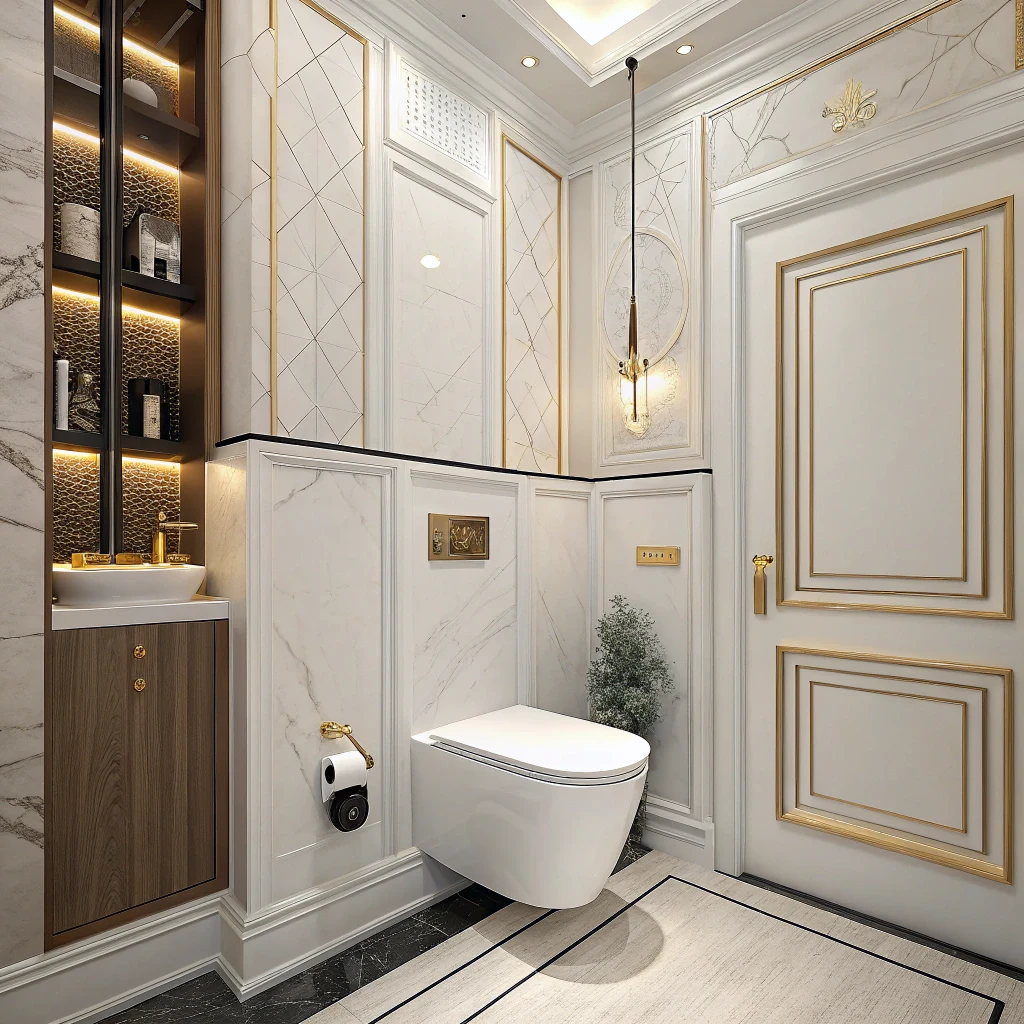
Space-Saving Benefits of Wall Hung Toilets
As urban living continues to evolve, maximizing space in our homes has become increasingly important. This is especially true in bathrooms, where every inch counts. As a Technical Sales Manager at MFBath, I’ve seen firsthand how wall hung toilets are revolutionizing bathroom design, particularly in compact spaces. Let’s dive into the space-saving benefits of these innovative fixtures and why they’re becoming a “Game-changer” in modern bathroom layouts.
Freeing Up Floor Space: How Wall Mounting Enhances Openness
The primary advantage of a wall hung toilet is its ability to free up valuable floor space. By mounting the toilet on the wall and concealing the tank within, you can gain up to 9 inches of floor space compared to traditional floor-mounted models. This seemingly small change can have a significant impact on the overall feel of your bathroom, creating an illusion of more space and enhancing the room’s openness.
“Wall hung toilets can save up to 9 inches of floor space, significantly improving the layout and perceived size of compact bathrooms.”
Ideal for Small Bathrooms: Case Studies of Compact Layouts
In urban apartments and small homes, where bathrooms are often confined to minimal square footage, wall hung toilets shine. We’ve seen numerous case studies where the installation of a wall hung toilet has transformed a cramped bathroom into a more functional and visually appealing space. For instance, in a recent project for a boutique hotel in downtown New York, switching to compact toilets allowed the designers to include a full-sized shower in bathrooms that previously could only accommodate a cramped stall.
Custom Dimensions for Unique Spaces
One of the most versatile features of wall hung toilets is the ability to customize their height and projection from the wall. This flexibility allows for optimal space utilization in bathrooms of all shapes and sizes. At MFBath, we offer a range of space-saving toilets designed to meet the diverse needs of retailers supplying urban residential projects. Our models can be adjusted to fit into corners, under windows, or in awkward layouts where traditional toilets simply wouldn’t work.
Comparison with Floor-Mounted Toilets: Space Efficiency Metrics
When comparing wall hung toilets vs floor mounted toilets, the space-saving benefits become even more apparent. Let’s look at some key metrics:
| Tampok | Wall Hung Toilet | Floor-Mounted Toilet | Space Saved | Impact on Layout |
|---|---|---|---|---|
| Floor Space Used | 4-6 sq ft | 8-10 sq ft | 2-4 sq ft | Significant improvement in floor plan flexibility |
| Projection from Wall | 19-21 inches | 27-30 inches | 6-9 inches | Allows for easier navigation in tight spaces |
| Tank Visibility | Hidden in wall | Visible | N / A | Creates illusion of more space |
| Cleaning Area | Easy access under bowl | Limited access around base | N / A | Improves hygiene and maintenance |
| Height Adjustability | Customizable | Fixed | N / A | Enhances comfort and accessibility |
These metrics clearly demonstrate the space-saving advantages of wall hung toilets. Not only do they occupy less physical space, but they also contribute to a more open and flexible bathroom layout.
It’s worth noting that wall hung toilets are gaining popularity not just for their space-saving benefits, but also for their ability to address specific building code compliance issues related to space and accessibility. This is an aspect that many competitors overlook, but it’s crucial for ensuring that bathroom designs meet all necessary regulations, especially in commercial or public spaces.
At MFBath, we understand the importance of maximizing space without compromising on style or functionality. Our range of wall hung toilets is designed to meet the evolving needs of modern bathrooms, offering both space-saving benefits and aesthetic appeal. As urban living continues to demand innovative solutions, wall hung toilets stand out as a practical and stylish choice for bathrooms of all sizes.
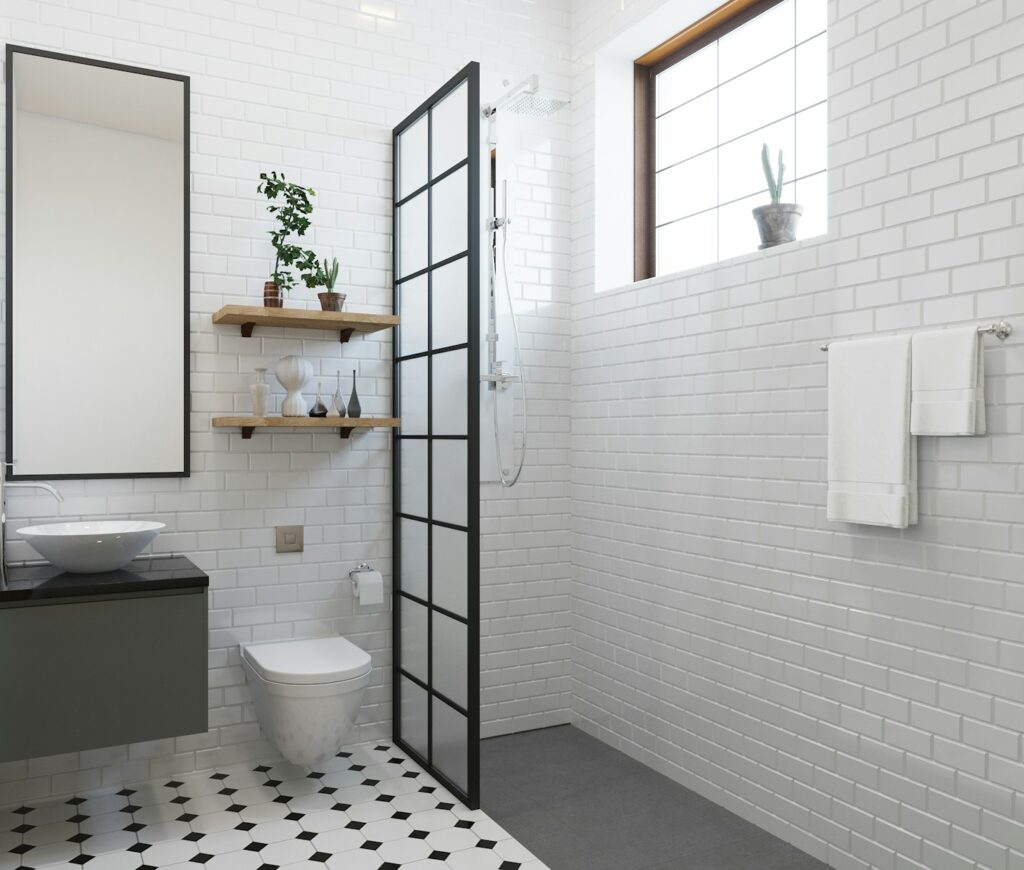
Installation Requirements and Best Practices
As a Technical Sales Manager at MFBath, I’ve guided countless professionals through the intricacies of wall hung toilet installations. While these fixtures offer numerous benefits, their proper installation is crucial for ensuring longevity, performance, and compliance with building codes. Let’s dive into the key aspects of installing wall hung toilets and explore some “insider tips” that can make the process smoother.
Wall Carrier Systems: Components and Structural Needs
The heart of any wall hung toilet installation is the wall carrier system. This hidden framework bears the weight of the toilet and houses the concealed tank. A typical wall carrier system includes:
- A sturdy metal frame
- A concealed cistern
- Mounting brackets
- Flush actuator
- Waste and water connections
It’s crucial to ensure that the wall behind the toilet can support at least 500 pounds of weight. In most cases, additional framing or blocking between wall studs is necessary to provide adequate support.
“Proper installation of the wall carrier system is critical for the longevity and safety of wall hung toilets, requiring careful attention to structural support and precise measurements.”
Professional vs. DIY Installation: Pros and Cons
While DIY enthusiasts might be tempted to tackle wall hung toilet installation themselves, we generally recommend professional installation. Here’s a comparison to help you understand why:
| Aspeto | Professional Installation | DIY Installation | Impact on Performance | Long-term Cost Implications |
|---|---|---|---|---|
| Expertise | Mataas | Varies | Crucial for proper functioning | Reduces potential repair costs |
| Tools Required | Specialized tools available | May need to purchase/rent | Proper tools ensure precise installation | Professional tools can prevent damage |
| Time to Complete | 4-6 hours | 8-12 hours (or more) | Faster installation minimizes disruption | Time is money in renovations |
| Code Compliance | Assured | Requires research | Critical for safety and legality | Avoiding fines and mandatory changes |
| Warranty | Often included | May be voided | Protects against defects and issues | Can save significant money on repairs |
Building Code Compliance: ADA and Accessibility Standards
When installing a wall hung toilet, adherence to building codes is non-negotiable. This is especially true for commercial installations or homes aiming for universal design. Key considerations include:
- ADA compliance: Toilet height should be 17-19 inches from the floor to the top of the seat
- Clearance: Minimum 60 inches of clearance from side wall to side wall
- Support: Must withstand 500 pounds of weight for public use
At MFBath, we provide detailed technical specifications and installation guides to ensure our products meet these standards when properly installed.
Common Installation Challenges and Solutions
Even for seasoned professionals, installing wall hung toilets can present unique challenges. Here are some common issues and their solutions:
- Uneven walls: Use shims and ensure proper leveling of the carrier system
- Insufficient wall depth: Consider using a slim-line tank system or partial wall build-out
- Existing plumbing location: May require relocation of water supply and waste lines
- Proper sealing: Use high-quality silicone sealant to prevent leaks
To support our retail partners and end-users, MFBath offers comprehensive installation support services. Our detailed FAQs and technical guidance are designed to streamline the procurement and installation process, addressing common concerns before they become issues.
It’s worth noting that the growing popularity of wall hung toilets isn’t just about aesthetics. These fixtures are increasingly chosen for their ability to address specific building code compliance issues related to space and accessibility. This aspect, often overlooked by competitors, is a key consideration in modern bathroom design.
By understanding these installation requirements and best practices, you can ensure that your wall hung toilet not only looks great but also performs optimally for years to come. At MFBath, we’re committed to providing not just quality products, but also the knowledge and support needed for successful installations.
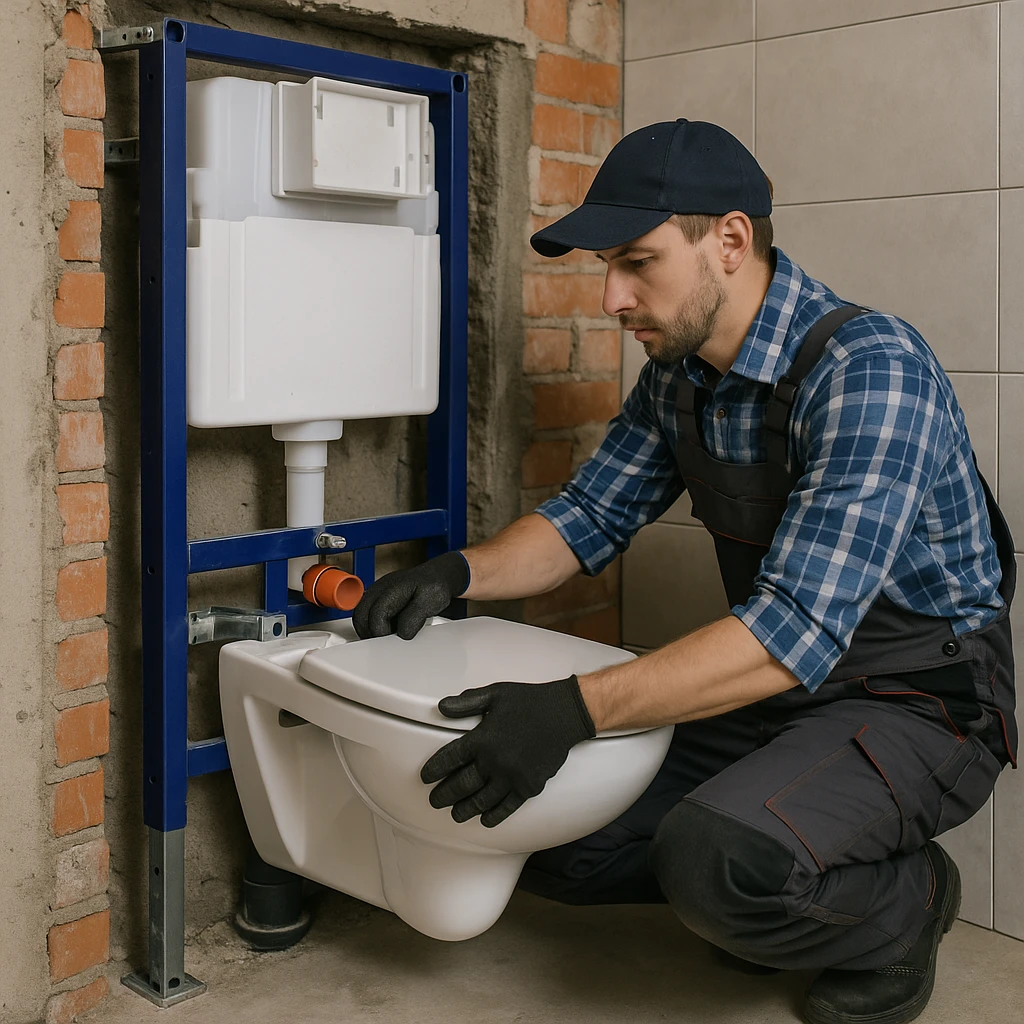
Aesthetics and Customization in Wall Hung Toilets
As a Technical Sales Manager at MFBath, I’ve witnessed firsthand the transformative power of wall hung toilets in modern bathroom design. These fixtures have become more than just functional necessities; they’re now pivotal elements in creating sleek, customized spaces that blend form with function. Let’s explore how wall hung toilets are elevating bathroom aesthetics and offering unprecedented customization options.
Minimalist Design: Streamlined Look for Modern Bathrooms
The appeal of wall hung toilets lies largely in their minimalist design. By concealing the tank within the wall and featuring a floating bowl, these fixtures create a clean, uncluttered look that’s “on point” with contemporary design trends. This streamlined appearance not only enhances the visual spaciousness of a bathroom but also simplifies cleaning and maintenance.
“Wall hung toilets epitomize modern bathroom design, offering a sleek, floating appearance that maximizes both style and space efficiency.”
Customization Options: Sizes, Finishes, and Smart Features
One of the most exciting aspects of wall hung toilets is the range of customization options available. At MFBath, we offer a diverse selection to cater to various design preferences and functional needs:
| Tampok | Options | Design Impact | Functional Benefit | Popularity Trend |
|---|---|---|---|---|
| Bowl Shape | Round, Elongated, Square | Affects overall bathroom aesthetic | Comfort and space efficiency | Elongated gaining popularity |
| Finish | White, Black, Metallic, Custom Colors | Complements overall color scheme | Ease of cleaning, durability | Matte finishes trending |
| Flush Actuator | Button, Lever, Touchless | Adds design detail | Water efficiency, hygiene | Touchless options increasing |
| Smart Features | Heated Seat, Bidet Function, Auto-Flush | Subtle tech integration | Enhanced comfort and hygiene | Growing demand in luxury markets |
| Height Adjustment | Standard, Comfort Height, Custom | Invisible customization | Accessibility, comfort for all users | Comfort height becoming standard |
Enhancing Property Value Through Design Appeal
The installation of wall hung toilets can significantly enhance property value, particularly in high-end residential and commercial projects. Their modern aesthetic and space-saving benefits are highly attractive to potential buyers and tenants. In fact, studies have shown that updated bathrooms with contemporary fixtures like wall hung toilets can increase property values by up to 5-10%.
Case Studies: Wall Hung Toilets in High-End Projects
At MFBath, we’ve had the privilege of supplying wall hung toilets for several prestigious projects. For instance, a luxury boutique hotel in Manhattan recently incorporated our customizable models in all 200 rooms. The sleek design allowed for larger shower areas, while the variety of finishes enabled the designers to create unique looks for different room categories.
Another notable project was a high-rise residential building in Singapore, where the developer chose our wall hung toilets with smart features for all units. The space-saving design was crucial in maximizing living areas in the compact apartments, while the modern aesthetic aligned perfectly with the building’s overall design ethos.
It’s worth noting that the benefits of wall hung toilets for small bathrooms extend beyond just aesthetics. These fixtures are increasingly chosen for their ability to address specific building code compliance issues related to space and accessibility – an aspect often overlooked by competitors but crucial in modern design and construction.
At MFBath, we pride ourselves on offering tailored solutions that appeal to interior designers seeking unique fixtures for luxury or boutique projects. Our range of wall hung toilets combines style with functionality, allowing for the creation of truly bespoke bathroom spaces that meet both aesthetic and practical needs.
As the trend towards minimalist, space-efficient design continues to grow, wall hung toilets are poised to play an increasingly important role in shaping the bathrooms of the future. Their blend of style, customization, and practicality makes them an ideal choice for those looking to create modern, sophisticated bathroom spaces.

Cost, Value, and Market Trends
As a Technical Sales Manager at MFBath, I’ve witnessed the evolving landscape of bathroom fixtures, particularly the rising popularity of wall hung toilets. While these innovative fixtures offer numerous benefits, it’s crucial to understand their cost implications, long-term value, and the market trends driving their adoption. Let’s dive into a comprehensive analysis of the financial aspects and market dynamics of wall hung toilets.
Initial Costs vs. Traditional Toilets: Breaking Down the Investment
It’s no secret that wall hung toilets generally come with a higher upfront cost compared to traditional floor-mounted models. However, to truly understand the investment, we need to break down the costs:
| Cost Factor | Wall Hung Toilet | Tradisyunal na Banyo | Difference | Long-term Impact |
|---|---|---|---|---|
| Fixture Cost | $300 – $1000+ | $100 – $500 | +$200 – $500 | Higher quality, longer lifespan |
| Installation | $500 – $1000 | $200 – $ 400 | +$300 – $600 | More complex, but offers future flexibility |
| Wall Reinforcement | $200 – $500 | N / A | +$200 – $500 | Ensures long-term stability and safety |
| Maintenance Costs (Annual) | $50 – $100 | $100 – $200 | -$50 – $100 | Lower due to easier cleaning and better efficiency |
| Water Usage (Annual) | $30 – $50 | $60 – $100 | -$30 – $50 | Significant savings over time |
“While wall hung toilets have a higher initial cost, their long-term benefits in water efficiency, maintenance ease, and space-saving design often justify the investment.”
Long-Term Savings: Water Efficiency and Maintenance Benefits
The true value of wall hung toilets becomes apparent when considering long-term savings. These fixtures typically use less water per flush, leading to significant water conservation over time. At MFBath, our wall-mounted toilets are designed with dual-flush systems, further enhancing water efficiency.
Maintenance is another area where wall hung toilets shine. Their design allows for easier cleaning, reducing the time and effort required for upkeep. This can translate to lower cleaning costs in commercial settings and increased longevity of the fixture.
Market Trends: Rising Popularity in 2025 and Beyond
The market for wall hung toilets is experiencing robust growth, with projections indicating continued expansion. Key trends include:
- Increasing adoption in urban residential developments
- Growing demand in the hospitality sector for their space-saving and aesthetic benefits
- Rising popularity in renovation projects as homeowners seek to modernize their bathrooms
- Increasing awareness of water conservation driving demand for efficient fixtures
It’s worth noting that wall hung toilets are gaining traction not just for their aesthetic appeal, but also for their ability to address specific building code compliance issues related to space and accessibility. This aspect, often overlooked by competitors, is becoming a significant factor in their increasing popularity.
Procurement Considerations: Sourcing Reliable Suppliers
When it comes to sourcing wall hung toilets, reliability and quality are paramount. At MFBath, we position ourselves as a trusted supplier with competitive pricing and reliable delivery. Our commitment to quality is backed by CE certification, ensuring that our products meet stringent European standards.
For retailers and designers looking for cost-effective solutions, consider the following when choosing a supplier:
- Product range and customization options
- Warranty and after-sales support
- Compliance with local building codes and standards
- Delivery timelines and stock availability
- Technical support and installation guidance
As we look at the cost, value, and market trends of wall hung toilets, it’s clear that these fixtures offer a compelling proposition. While the initial investment may be higher, the long-term benefits in terms of water savings, maintenance ease, and space efficiency make them an attractive option for both residential and commercial applications. As market trends continue to favor innovative, space-saving solutions, wall hung toilets are poised to become an increasingly popular choice in bathroom design.

Konklusyon
After years in the Mga Sanitary Ware industry, I’ve seen trends come and go. But wall hung toilets? They’re here to stay. These space-saving wonders aren’t just a passing fad – they’re reshaping how we think about bathroom design and functionality.
From urban apartments to luxury hotels, wall hung toilets are proving to be a “Game-changer” in maximizing space and elevating aesthetics. Yes, they come with a higher upfront cost, but the long-term benefits in water efficiency, easier maintenance, and design flexibility make them a smart investment.
As we look to the future of bathroom design, one thing’s clear: wall hung toilets are setting a new standard for modern, efficient living. Whether you’re a homeowner, designer, or retailer, it’s time to take a serious look at these innovative fixtures. Trust me, your bathrooms (and your clients) will thank you.
FAQ
-
Q1: What are the benefits of wall hung toilets?
A1: Wall hung toilets save space, offer modern aesthetics, and are easier to clean compared to traditional floor-mounted toilets. They also allow for adjustable height during installation.
-
Q2: How do you install a wall hung toilet?
A2: Installing a wall hung toilet typically requires a wall reinforcement for support, mounting the toilet tank inside the wall, and connecting the plumbing. Professional installation is recommended due to complexity.
-
Q3: Are wall hung toilets suitable for small bathrooms?
A3: Yes, wall hung toilets are ideal for small bathrooms as they provide a compact design, freeing up floor space and creating a more open feel.
-
Q4: What is the height of a wall hung toilet?
A4: The standard height for a wall hung toilet installation is approximately 15 to 20 inches from the floor to the seat, but it can be customized based on user preference.
-
Q5: How much weight can a wall hung toilet hold?
A5: Most wall hung toilets can support a weight capacity of around 500 pounds, depending on the mounting system and wall structure.
-
Q6: What are the drawbacks of wall hung toilets?
A6: Drawbacks include higher installation costs, potential plumbing complications, and the need for wall reinforcement. Maintenance access to the tank may also pose challenges.
-
Q7: Can wall hung toilets be ADA compliant?
A7: Yes, many wall hung toilets can be installed at wheelchair-accessible heights, making them suitable for ADA compliance. These toilets often feature comfort height options.
-
Q8: Do wall hung toilets have a hidden cistern?
A8: Yes, wall hung toilets typically use a concealed cistern that is mounted within the wall, making them aesthetically pleasing while saving space.
Mga Panlabas na Link
- KEY ADVANTAGES OF WALL-HUNG TOILETS (and how to choose one) – Geberit
- Pros and Cons of Wall-Mounted Toilets – Consumer Reports
- Wall Hung Toilets | Pros, Cons & Advice – The Bathroom Blueprint
- In-wall Toilet Systems | Geberit USA
- 6 Best Wall Hung Toilets: In-Detail Reviews (Spring 2025) – Bathroomer
- Best Wall Mounted Toilets Reviewed – Plumbing Lab
- AP DuoFit Wall Hung Two-Piece 0.9/1.28 GPF Dual Flush Elongated Toilet – Home Depot
- 6 Best Wall-Hung Toilets in 2025 — Reviews & Top Picks – HouseGrail




